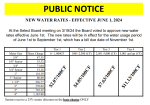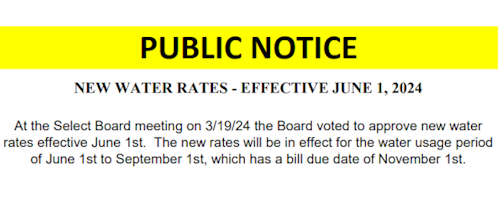Above: The Town is alerting water customers that rates and fees will be increasing. (image cropped from Town website)
For residents and businesses on the Town’s water system, rates will be going up 3.5% next quarter. The increased charges will be effective June 1st.
The bills will also include a 24.8% base charge increase, regardless of how much water the customer uses. However, for the average residential user, the increase is estimated as less than $50 per year (about $12 per quarter) starting with the bills issued in October.
On the plus side, the MWRA recently confirmed that the Town’s supply is well within the EPA’s more stringent safety guidelines issued this month.
Here are more details on all of that, including why the base charge increase is bigger than was projected last year.
Starting off with the good news:
MWRA Meets New Quality Standards
Two weeks ago, the EPA issued new regulations for drinking water to ban “forever chemicals”. According to news reports, the new standards are stricter than even Massachusetts’ regulations, which were more stringent than the prior national regs.
That means that some Towns will have to grapple with how to meet the new standards. Fortunately, Southborough’s water system isn’t one of them.
The MWRA, which supplies the Town’s water updated its website to reassure the public. It states:
MWRA has tested for all six of the compounds included in the new EPA rule, as required by current state regulations. Our results are either not-detectable or at trace levels so low they can’t be quantified. All MWRA PFAS results are posted on MWRA’s web site. (read more)
New Rates effective June 1st
Following the same model as approved last year, anyone connected to the Town water system will be charged according to the size of their meter. The highest charges are for large meters generally only used by businesses.
 For residents, the charges range from $47.35 for a ⅝” meter to $118.39 for 1½”. Seniors ages 65+ will receive a 25% discount on those charges. (If you are newly a senior, or haven’t been getting your entitled discount, click here to apply for it.)
For residents, the charges range from $47.35 for a ⅝” meter to $118.39 for 1½”. Seniors ages 65+ will receive a 25% discount on those charges. (If you are newly a senior, or haven’t been getting your entitled discount, click here to apply for it.)
Water usage is then charged based on the cubic feet used. The highest rates are reserved for the highest usage.
According to the Town’s consultants (the Abrahams Group), Southborough’s average homeowner has a ⅝” meter and uses 2,600CF. Last year, that would have cost about $136 per quarter. Starting in June, the bill would be over $148 per quarter.
Base Charge Increases Larger than Anticipated Last Year
In an April 2023 presentation, he Abrahams Group projected that Southborough would only need to increase the Base Charge fees by 3% annually. But in this year’s presentation, the recommendation was a 24.8% increase.
In March meetings with the Select Board, DPW Superintendent Bill Cundiff and consultant Matt Abrahams explained that much of that was related to an unforeseen increase in costs related to personnel.
There was only an 8.6% increase in salaries. But, the Town realized that when employees’ time is charged to the Water Enterprise Fund, an equal percent of their OPEB costs should also be charged to that budget. That includes for employees in other departments (like Finance) that support the Water Dept. That change contributed to a 49.1% increase in Indirect Costs.
[Note: For those unfamiliar with OPEB, it is the “Other Post-Employment Benefits” the Town sets aside to fund future employee retirement expenses.]
During the presentation, the Select Board was told that less money was collected last summer than expected, since it was an unusually rainy season.
The original recommendation on March 4th was for the board to raise usage rates to by 3%. At that time, Cundiff was under the impression that the change could be included on the next bill.
At the March 19th meeting, he noted that they would have to wait an additional quarter since the July bill will cover water used since March 1st readings. To make up for the lost revenue, the user rates would have to be upped to 3.5%.
One of the planned infrastructure projects that fixed costs collected need to help cover is installing a new 12-inch water main between Presidential Drive and Fisher Road. The “looping” connection is to address water pressure issues in that area of town.
Other planned water infrastructure projects weren’t part of the cost/revenue analysis, since the Town expects Hopkinton to cover those costs. (More on that below.)
Also not included was any expenses for dealing with lead contamination discovered on the site of a former water tower. (Stay tuned for a future post about the Atwood lead issue.)
Hopkinton Water Connection Project
There’s not a lot of news on this front. The project is still expected to happen, just moving slowly.
Even before the EPA issued new standards, our neighbors to the southwest were struggling to grapple with their water supply’s failure to meet state safety standards.
The discovery of too-high PFAs levels in the Town’s wells prompted them to reach out to Southborough to pursue a project that would connect their water supply to the MWRA through our water system.
I reached out to our Town’s liaisons for the project for a status update. When the EPA made the April 10th announcement, government official pledged to make available grants to help cities and towns address problems.
I wondered if that opportunity could derail things by giving Hopkinton officials/voters incentive to pursue internal infrastructure improvements rather than the connection. Their agreement with Southborough includes not only covering the project costs, but also $1M worth of unrelated water infrastructure improvements in Southborough.
Both John Butler and Select Board Vice Chair Kathy Cook believe that it won’t lead to any changes. Butler wrote that although Hopkinton hasn’t yet signed the Intermunicipal Agreement, they have been spending hundreds of thousands of dollars on continuing an engineering design based on the Southborough connection. He believes the IMA holdup has been based on management turnover in the town. He acknowledge he doesn’t have a crystal ball, but:
They are far down the much better path of connecting to MWRA. Only MWRA offers abundant supply and great water.


